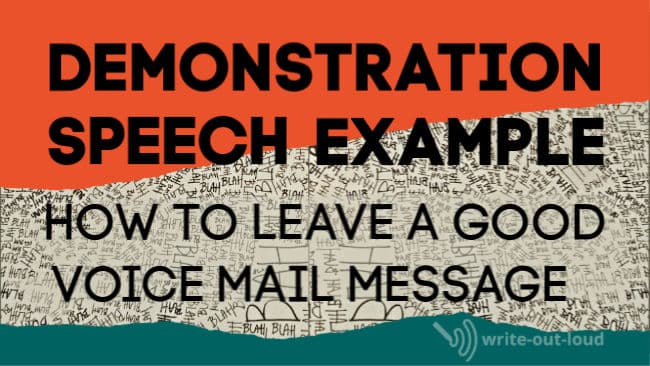- HOME ›
- Understanding demonstration speeches ›
- Demonstration speech sample outline
Demonstration speech sample outline
How to leave an effective voice mail message
By: Susan Dugdale | Last modified: 02-12-2023
The demonstration speech sample outline below follows the logical step-by-step process that is essential for any "how to" type of speech. E.g., how to fix a flat tire, how to play a board game, how to make a friendship bracelet, how to put together a kick starter campaign...
An outline is a great tool: one of the very best ways to prepare an effective demonstration speech. It allows you to map out an entire speech about a particular process in easy steps.
Quite simply, you need one to ensure you're on track in front of an audience, that your series of main points are in the right order, that your use of visual aids is smooth...
The specific task the speech I've prepared to show you how it works covers what's involved in leaving an effective voice mail message: one that doesn't get deleted immediately!
You'll see that each part of the outline builds on what went before it, leading the audience from start to finish through the number of steps needed to put a good voice message together.
Get a printable blank demonstration speech outline

The outline template I've used is available for your use too. I've made a printable blank version of it for you download.
You'll find the link at the foot of the page, along with a video of the speech.
The voice you'll hear, when you play that, is me, Susan. (If you're on a desktop, see the photo in the righthand column!) And my accent is New Zealand.
About this demonstration speech example
As I was preparing this 'how to' I had in my mind young adult audience members: high school, or college students.
The speech covers one of a number of vital soft skills* needed to open doors to work opportunities, or to make connections with people who can help them to get where they want to go. Leaving an effective voice mail message is often the very first step on that journey.
*For more soft skills demonstration speech topics.
Which bits of this speech outline are said aloud?
Everything in bold eg. Title of speech, General purpose ... is not said aloud. These are the titles or labels of the various parts of the speech outline template.
Anything in italics eg. Gathering your information your information ... is not said aloud.
The speech itself begins with these sentences:
'How many important voice mail messages have you bumbled through after the beep? Does recalling them make you feel a little uncomfortable?'
Demonstration speech sample outline
Title of speech: How to leave an effective voice mail message after the beep
General purpose: to demonstrate
Specific
purpose: to demonstrate (teach) how to leave a good voice mail
message
Central
idea (thesis statement): save yourself and the person you’re
leaving the message for the frustration caused by: you not getting
the result you wanted and the person you left the message for not
understanding what you wanted.
Introduction
Attention grabber:
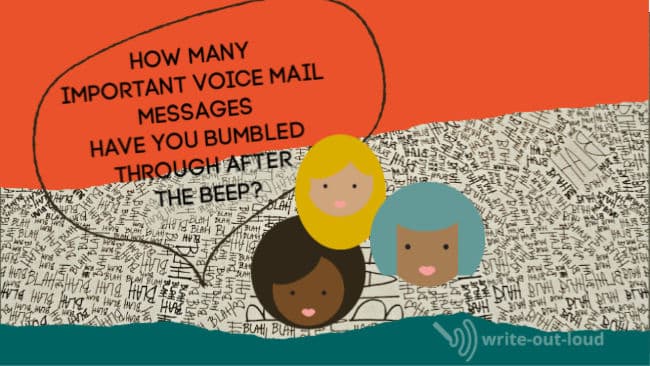
How many important voice mail messages have you bumbled through after the beep? Does recalling them make you feel a little uncomfortable?
Credibility
builders:
Yep,
me too. I’ve blundered. Mumbled and muttered. If it were possible,
I would have gladly saved the person I was calling the hassle of
deleting those messages myself. Before they were heard.
However no more. I’ve learned how to leave an effective voice mail message. One expressing politely, clearly and succinctly all that was needed for whoever listened to it to understand exactly what I was calling about. One that that wouldn’t make me cringe if I heard it.
Preview:
Today
I’m going to share how to do that with you.
No more embarrassment. No more tongue-tied after the beep blues. This is a skill easily gained, and one that will open doors for you again, again and again.
Transition:
Are
you ready? Let’s go.
Body of speech
Step
one:
A lot of the time we already know as we’re entering the numbers for whomever we’re calling: our plumber, the manager of our local community center, or to request information about an advertised job vacancy that the likelihood of our call going through to voice mail is reasonably high.
So here’s the first step toward crafting a good message. Gather up everything we want to say before entering the phone numbers of the person we want to talk to. This will ensure we give ourselves the best chance possible of avoiding the dreaded ‘delete’.
(Show visual aid : Who, what, why, when, where and how chart.)
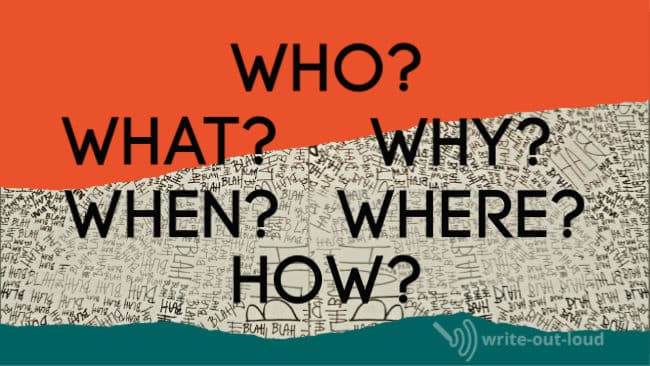
Sub-step
one:
We
need to cover off who, what, why, when, where and how. Depending
on what we want to say, some of them, more than once.
Who we are. Eg. Joe Smith
Where from. Eg. Forest Farm
How we can be contacted. Eg. My number is 021 445 8834
Who we want to talk to. Eg. Sam White. (This step is needed if we’ve not directly gone through to the voice mail of the person we want to speak to.)
What we’re calling about: Eg. the planned community tree planting day
Why we’re calling: Eg. to confirm the numbers of trees required
When we need an answer: Eg. by next Tuesday
Transition
It’s fairly straightforward, isn’t it? Pure logic, that you would think before you speak and have your message organised. Alas, some of us don’t. Then in the nano-second following the beep suffer a logic by-pass and side step into voice-mail hell.
Step
two: Reviewing the worst types of voicemail messages
It’s
worth reviewing what types of voice mails make themselves candidates
for instant dismissal. Here’s a few of the worst in all their
ghastly glory from the ‘what not to do’ department. Consider
them aversion therapy!
Sub-step
one: Examples
The
longest ever. Squeezing in every little detail possible is
unnecessary. It is quite literally, too much.
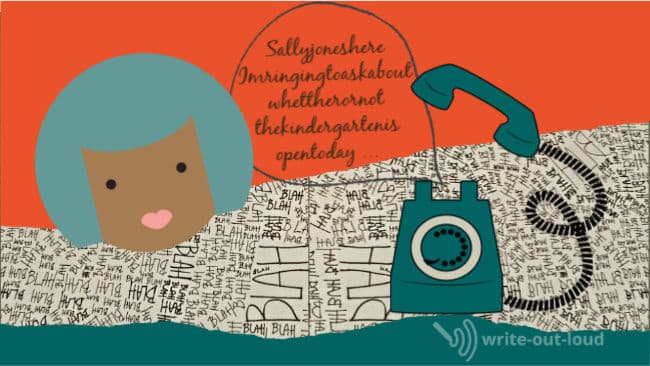
The gabbler. The person who talks so quickly that it’s impossible to make out what they’re saying.
The anonymous. The person who presumes you’ll know who is speaking, and you’ll also know how to contact them, so they don’t tell you.
The ummer and ahhher. This person leaves a message made up of 75% filler words and 25% substance - making it hard to summon the enthusiasm to dig through the dross for the gold.
Transition
Let’s
leave gobble-de-gook voice mail behind us.
Step three
Let’s start right now by preparing a message that ticks all the boxes. It will let the person you’ve called know who is calling, your number so that they can return the call, what you are calling about clearly, and briefly, and what you would like, or want, the person you’ve called to do. It’s both friendly and professional.
Sub-step
one
To
do this we’ll return to who, what, where, when, why and how
(Display chart)
Sub-step
two
To
demonstrate we’ll use the example mentioned earlier.
We’ll pretend we’re Joe Smith from Forest Farm, calling Sam White, the manager of the local Community Outreach Center, about the planned tree planting day coming up soon. Joe has previously agreed to supply the trees and now needs to know which varieties, and how many of each them are wanted. He would like an answer by next Tuesday.
Sub-step
3
Now
let’s prepare the message.
Hi
Sam
Joe
Smith here from Forest Farm
021
445 8834
I’m
calling to finalize the varieties and numbers of trees required for
our tree planting day. To get them ready we need to know by next
Tuesday. Thanks. Looking forward to hearing from you.
Sub-step
4
Now
let’s check it.
Does it cover everything it should?
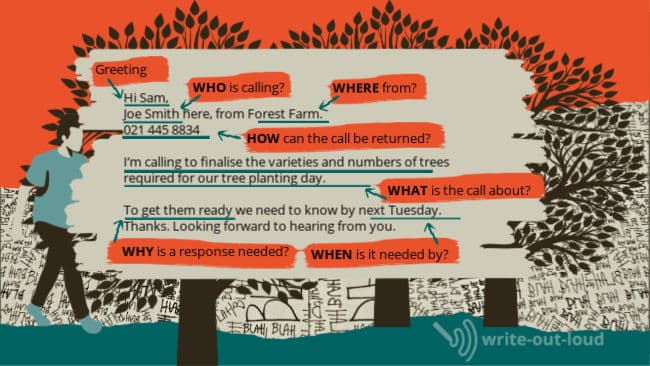
Does it cover everything it should?
A greeting? Yes.
Say who it’s from? Yes. Joe Smith (That’s ‘Who’)
Provide the person called with context? Yes. Forest Farm. (That’s ‘Where’.)
Give contact details? Yes. (That’s ‘How’ covered - how to return the call.)
Give a brief, clear reason for leaving the message. Yes. (The ‘What’ is the varieties and number of trees needed.)
Give a reason ‘Why’? Yes. To get them ready in time we need that information soon.
Give a time frame? Yes. (That’s ‘When’ sorted.)
Transition
OK
- so this is the type of voice mail message we’d like to leave, and
receive. Therefore the next major step is practice.
Step four
Rinse and repeat! The only way to master leaving quality voice mail messages is to practice. A lot.
Sub-step
one
Use
the recording function on your phone to record yourself leaving
messages of varying types. For instance: asking for an appointment
or reminding someone they were going to get back to you a few days
ago and haven’t.
Sub-step
two
When
you play them back listen carefully.
- Are you speaking clearly?
- Have you avoided filler words? (Um, ah, like, yeah ...)
- Have you carefully and slowly given your number ?
- Is the tone of your voice friendly? (Smiling while you talk will make it sound that way.)
- Is your message brief and does it cover everything it needs to? (That’s the who, what, where, why, when and how.)
- Are the words you’ve chosen to use appropriate? (The vocabulary we use with a close friend is often very different from the words we’d choose to talk with a prospective employer. Getting it wrong could have consequences!)
Sub-step
three
If you’ve answered ‘no’ to most of these questions. You already know what you need to do. More practice. Like any new skill it takes a while to become second nature – a habit. Keep at it.
Yes, to some aspects and no, to others? Keep practicing, focusing on what you need to master.
Yes, to everything? Congratulations. You’re ready to go.
Transition
You see? It’s not that hard.

Conclusion
The
voice mail messages we leave represent us. They’re personal
ambassadors – making our way forward easier, or harder. A well
crafted message is much more likely to be heard in its entirety and
acted on. Pause before you call. Think. Structure. Then ring and
speak with confidence!
Listen to this demonstration speech example
I've recorded it and added some slides to make it a 'show and tell'.
Either click this link: How to leave an effective voice mail message, or on the image above to play it.
Feel free to share, comment, like, or dislike it, as you see fit!
Download the blank speech outline template
This template is a pdf. To open, read and print it you must have a pdf reader installed on your computer. If needed here is a link to download the free Adobe Acrobat Reader DC software you require.
If you haven't much time to sort out the best topic for your target audience, to find interesting facts and additional information to support it, to the think through the series of steps required and prepare for a q&a session at the conclusion of your presentation, completing an outline is great way to lessen your stress levels!
More resources for demonstrative speeches
100s of topics for demonstration speeches

Here's a collection of 290+ demonstration speech topics, including that evergreen favorite: 'how to choose a pet'.
And here's another selection of good examples of demonstrative speech topics arranged by theme: business, entertainment, frugal living, caring, public speaking.
The previously mentioned soft skills 'how-to' speech ideas are here: 50 speech topics focusing on 'soft skills'.
Plus, there's 100 short 3-10 minute demonstration speech ideas, 188 funny how to speech topics and guidelines on how to prepare the best demonstration speech you can.
PS. For more on voice mail messages
Check these excellent links:
- The ten worst types of voice mails - an evergreen article published on the Grasshopper blog. (Thank you!)
- How to leave professional voice mail messages - published by Energy Resourcing
- How to leave a professional voice mail message - published by 'the balance small business'.
